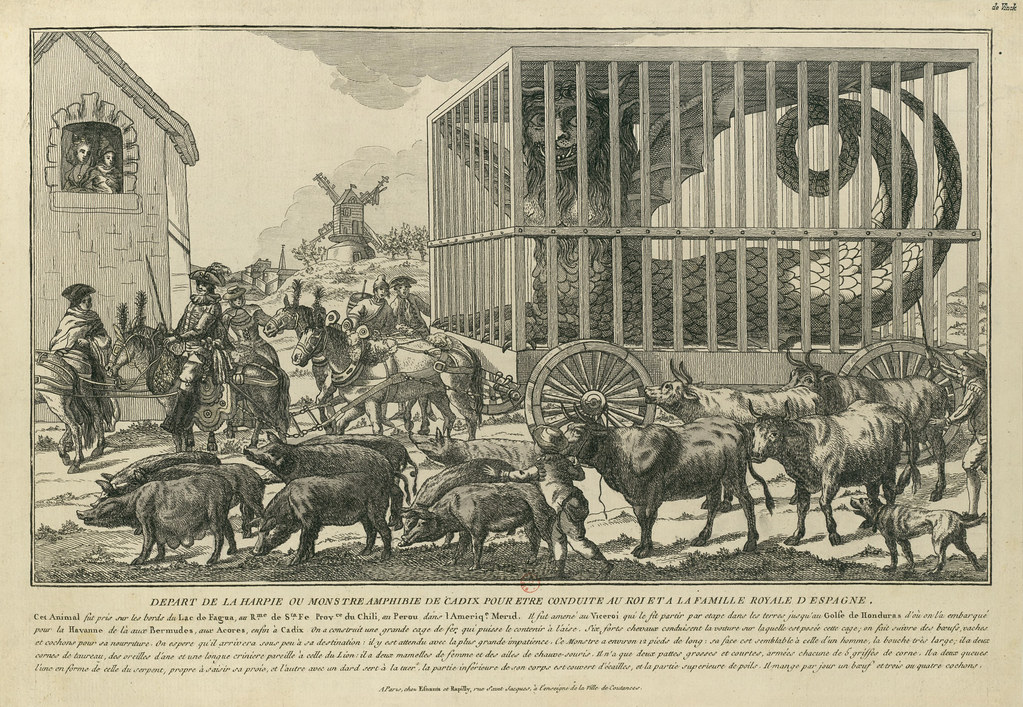
Artist unknown, the French text from the engraving, "Départ de la Harpie ou monstre amphibie de Cadix pour être conduite au roi et à la famille royale d'Espagne" roughly translates to the following in English.. "Start the Harpy or amphibious monster of Cadiz to be brought to the king and the royal family of Spain." It's like an ancient version of King Kong.
Full translation provided by Wood. "This animal was taken on the banks of the lake of Fagua, in the Realm of Santa Fe, province of Chile, in Peru in the Meridional America. It was taken to the Viceroy qui made it travel inland to the Gulf of honduras where it was shipped to Havana and from there to Bermuda in the Azores, and lastly to Cadiz. A great cage was built, who could easily contain it. Six strong horses lead the cart on which this cage is resting ; Oxen, cows and pigs are made to follow, in order to feed it. It is hoped it will soon reach its destination, where it is most impatiently waited. This moster is roughly 12 foot long : its face is like that of a man, the mouth very large ; it has two bull horns, donkey ears and a long mane like that of the lion : it has two woman's teats bat wings. It has only two paws large and short, each armed with 5 horn claws. It has two tails, one shaped like that of the snake, able to seize its prey, and the other with a sting is used to kill it, the lower part of its body is covered with scales, and the upper part with hairs. It eats every day and ox and three pigs.
In Paris, at Esnauts & Rapilly, rue Saint Jacques, at the sign of the City of Coutances"
Image found while digging through the Gallica Digital Library.

6 comments:
"This animal was taken on the banks of the lake of Fagua, in the Realm of Santa Fe, province of Chile, in Peru in the Meridional America. It was taken to the Viceroy qui made it travel inland to the Gulf of honduras where it was shipped to Havana and from there to Bermuda in the Azores, and lastly to Cadiz. A great cage was built, who could easily contain it. Six strong horses lead the cart on which this cage is resting ; Oxen, cows and pigs are made to follow, in order to feed it. It is hoped it will soon reach its destination, where it is most impatiently waited. This moster is roughly 12 foot long : its face is like that of a man, the mouth very large ; it has two bull horns, donkey ears and a long mane like that of the lion : it has two woman's teats bat wings. It has only two paws large and short, each armed with 5 horn claws. It has two tails, one shaped like that of the snake, able to seize its prey, and the other with a sting is used to kill it, the lower part of its body is covered with scales, and the upper part with hairs. It eats every day and ox and three pigs.
In Paris, at Esnauts & Rapilly, rue Saint Jacques, at the sign of the City of Coutances"
In the upper corner, it says "de Vinck" ("of Vinck" or "from Vinck") Maybe that's the name of the artist ?
Wood, thank you for the translation! And I considered de Vinck and researhed the name, finding out they're the collector who for whatever reason felt compelled to sign the artwork. If anyone knows who the artist is, I'd love to know!
Beautiful picture and translation!
There is a de Vinck collection at the Bibliotheque Nationale in Paris--it is something 25,000 prints from I believe primarily the 18th and 19th centuries. Obviously I cannot be sure of this, but I suspect that the de Vinck tag probably refers to it being part of that collection. Paul, Los Angeles, www.empiredelamort.com
There are five more versions of this Harpie here....
http://plbh88.blogs.wm.edu/
with an account of it's various political meanings.
A search for 'Harpie print' on google images finds more versions of the creature. It looks as if the artist has composed his picture by putting together images from more than one print, because the Harpie is drawn in a different style from the animals in the foreground. Paul Rumsey.
Post a Comment